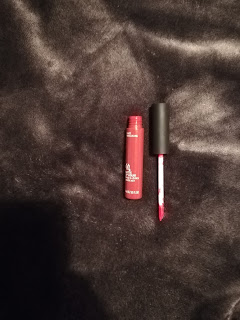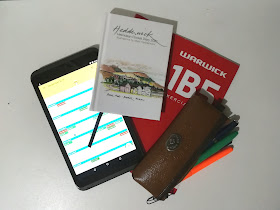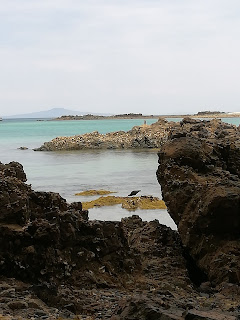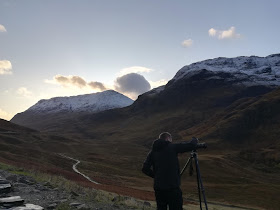Okay,
so my goal achieving this year has been a definite fail. Other than
doing the drystone walling course I probably haven't achieved any of
my aims for 2019. But then, it's just been one of those years where
life happens and unfortunately the happens were rarely good. I also
decided, pretty last minute, to travel to New Zealand for four months
and most of this quarter has either been me here in New Zealand or
getting myself ready to go. Here's how I did this quarter.
This
one's been a little strange since I've moved to New Zealand as the
heat here (especially after leaving Scotland mid-November) has been
so hot I haven't been hungry. It fact I've been having to force
myself to eat most of times and there have been many days were lunch
hasn't even been a thing. This isn't great really, though I haven't
actually been doing much strenuous activity to actually need all the
energy I would get from recommended three meals and, on the plus, I
have been drinking a lot more water. The main worry here is that I'm
not getting enough of the nutrients I actually need from just the two
meals and some snacks so I am going to really need to look at were I
can improve just for my general health. I do take multivitamins
(when I remember) but I really don't like relying on that for my
nutritional intake. I'd much rather get it from my food and my main
focus really is getting enough iron as that has always been a problem
in the pass.
As
for when I have been actually eating the meals have been pretty
healthy and basically made from scratch. They've mostly been
overnight oats for breakfast, nuts and corn gluten-free crackers with
Marmite for snacks, and a big rainbow salad for dinner. Even before
I travelled to New Zealand and was still working in the Scottish
Highlands my meals were healthy and mostly made from scratch. I am,
however, eating a lot less chocolate and weirdly less ice cream since
moving to New Zealand. So that's been a plus a least and I am, of
course, completely ignoring the blip of the couple of weeks we used
to see family in the UK before heading south of the equator. There
definitely wasn't a lot of healthy eating there and even some
sneaking in of fast foods. Though my Mum's home cooked meals tend to
be on the healthy side, we'll just ignore all the cream teas we had
as we were in Devon......so it doesn't count.
The
one very large polka dot elephant in the room is of course my
consumption to the black, fizzy stuff. I would even call it an
addiction. I'm not even sure I enjoy it when I do have it, but there
it is calling to me. I think 2020 should be the year I just stop
with it all together. Using it as a 'treat' just isn't working and I
probably won't miss it when it's gone.
Having
written this out I have to admit I am probably doing a little bit
better than I initially thought. My diet is relatively healthy on
the whole and I have gotten rid of most unhealthy snacking and eating
habits. Treats now and then are not something I'm going to hold
against myself or are something that are particularly bad for me when
done in moderation. I just need to keep an eye on it so they don't
sneak back in and I definitely need to break the lure of the black
juice.
I
had already managed to get my waste levels pretty low in the UK
before travelling out to New Zealand, but with the life style we're
living here at the moment (which is basically living in Airbnbs,
camping, and house-sitting) we've managed to reduce the waste even
more as we're basically living out of our car and don't really want
to buy any more stuff than we really need. Every purchase has been
really intentional, and that has led to much less waste. There is
one thing I do really need to remember to do though, and that is to
carry my usable mug with me everywhere as I have been caught out a
couple of times now and, as I have the thing, I have no excuses for
that.
As
for Christmas presents, I did my best to reduce the packaging in this
area as much as possible by buying items together buying from actual
shops, and selecting as ethical products as I possible could. And
when it came to wrapping the presents I used recycled brown paper
which were then stamped with snow flakes stamps I had brought a few
years ago, and finished with re-usable gardeners twine. I also made
all my own Christmas cards this year using cross-stitch patterns, but
this is an area I think I can improve on waste wise next year.
The
one area where I am still struggling with waste reduction is
groceries and the plastic they have wrapped around so many of the
vegetables. I really don't understand it and I've found that even
the grocers here still wrap things unnecessarily in the shiny stuff.
It annoys me and I do try and make decisions on the food I buy based
on whether or not the plant has plastic around it, but it's not
possible to do all the time. I definitely don't bother putting
multiples of the same loss item into a plastic bag myself. I really
don't see the point in that. They'll find each other in the cooking
pot.
As
with healthy eating, I'm going to keep trying to reduce my waste and
I think this is something that is never going to stop for me.
Learning
Skills
Since
travelling over to New Zealand I have done a fair amount of walking,
but in all these walks I haven't actually needed a map or a compass
as all the paths are well marked and each junction is signed. This
has meant that the opportunity to practise any orienteering skills
hasn't really been there. I have, however, noticed that there are
some orienteering groups in the area of New Zealand where I am based
and I think I'm going to research what they are actually doing and
whether or not it's worth me getting involved in the time I have left
here.
This
is probably the area where I have failed the most this quarter.
Since the beginning of November I haven't done any more of my British
Sign Language lessons at all. Which is a real 'shame on me' and I'm
a little worried that I've forgotten some of the signs I've already
learnt. I have done four lessons out of the seven this year and I
still have some time next year before my year's pass has run out.
This gives me time to actually get the course finished and properly
practise the signs until they become a little more instinctive.
The
only real issue for me at the moment is not being able to practise
signing with someone else as this is a really important part of
learning a new language. One option would be to practise here in New
Zealand as I've read that their sign language actually stems from the
British sign language, so there is bound to be some real overlap. I
think this one is definitely going to be a roll over goal for 2020.
I want to get it done before my holiday ends in March.
As
I said earlier, this year has been a bit of disaster when it comes to
achieving my goals. But you know what that's fine. It happens
sometimes and this year is coming to a close with a new one about to
begin. I just need to look at where this year went wrong, learn,
draw and nice line under it and move onto the next. I have an idea
of what I want my goals to be for next year but I want to really
flesh them out and make sure that they're what I want for myself
moving forward as I think one of the problems for 2019 was I didn't
really see how the goals fitted into my long term plans. So bring on
2020, I'm going to work on making it a much better year than 2019.























































